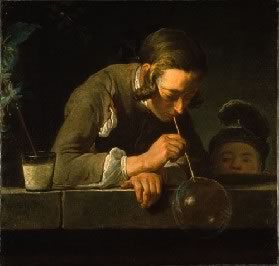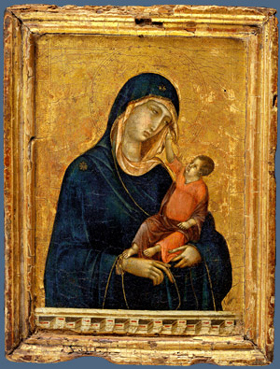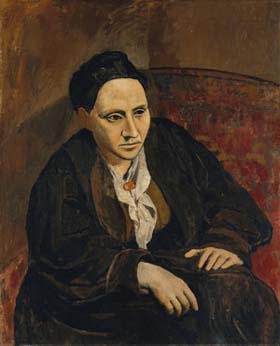No Going Back
John Haberin New York City
A Museum Reopening and Making the Met
Twenty-four weeks to the day, I was back in a museum. I was also celebrating one, one hundred and fifty years after the founding of the Metropolitan Museum of Art in 1870.
New Yorkers have postponed plenty of celebrations this year, and "Making the Met" is no different. It had planned to open closer to the anniversary, on April 13, but here it was, at summer's end. With it, the city itself took a giant step toward reopening. Where else but the Met can one walk indoors a few city blocks to an exhibition or event? But could I simply pick up where I left off, as if nothing had happened? And was I celebrating the museum as it has always been or as it is now? In more than one way, the museum seems unable to know itself. 
For its reopening, the Met has commissioned large banners by Yoko Ono, framing the Beaux-Arts entrance in pristine white. Their words have all Ono's insufferable optimism, Dream Together. Still, that is exactly why you and I go to museums, to dream together. Maybe we can start again, with adequate precautions. Now if only the museum did not feel as if it were talking to itself. Self-congratulation can take the festivities only so far.
A cause to celebrate
Art after Covid-19 comes in the wake of lost revenue and permanently closed galleries in Covid New York. The Met has laid off two hundred and lost millions. It had to close early its survey of Gerhard Richter, along with the Met Breuer (although four Birkenau paintings have since gone on temporary display at the Met), and it has to reinvent itself as a museum with social distancing, like the atrium for Amanda Williams at MoMA. Those paying full "suggested admissions" (mandatory for visitors from out of state) can buy tickets online and waltz right in. Locals had better be prepared to wait in line. Members, who can take the less crowded south entrance, have the shock of absent school groups and rolled up benches.
Regardless, you will have cause to celebrate. Maybe you have found solace in six months of "virtual exhibitions," virtual art fairs, and virtual drinks with the director of the Frick Collection. If so, you will have had good practice, for the rooftop bar and nonvirtual dining options are closed. Still, you can relish how much you have missed. Besides the anniversary party, you will be late in coming to a long-overlooked series by Jacob Lawrence and Héctor Zamora on the roof. And "Making the Met" has all the shock of the real thing.
It has, though, fewer surprises than you might think—and fewer favorites, even at some two hundred and fifty works. It seems unable to decide whether this is business as usual or something new. Does the whole idea of an anniversary show sound tired? Expecting the usual assortment of periods and decorative arts? It has armor, but a blunt helmet from World War II rather than the Great Hall's shining medieval armor. It has textiles and sacred relics, but painting rules.
Expecting greatest hits across the board, as in the galleries for European painting after the Skylight Project? It can count Jan Vermeer and Rembrandt among its earliest acquisitions. (A celebration of Rembrandt's four hundredth birthday in 2008 also celebrated the Met's collection.) Rembrandt paints Bathsheba as a seated nude in intense light, amid clothed attendants in a murky landscape. He makes the viewer a voyeur, much like King David in the Bible, and so does she with a winning smile. Still, not even he can compare with the Met's Dutch painting in, for now, the Lehman wing.
It has new acquisitions, like Pablo Picasso from Cubism's peak in early 1914. A seated nude holds a scrap of newspaper, but her bulk and her armchair overwhelm everyday life. Her pointed tits could function as sex objects or a weapon. Another new acquisition, by Carmen Herrera, continues the rediscovery of an abstract artist and a woman past the age of one hundred. Still, I could not grasp the Met's stake in modern art until my way out of the museum, through the wing for modern art and past murals by Thomas Hart Benton. It finally hit me that I was back in a museum.
It has women, like Herrera and Georgia O'Keeffe—in photos by Alfred Stieglitz and gloriously on her own in 1931. She sets her cow's skull against red, white, and blue as a portrait of America. Stieglitz also donated a dark photo by Gertrude Käsebier. A precisely observed watercolor by Margaret Nielson Armstrong refuses to become a footnote to J. M. W. Turner. Another woman, Frances Moore, was among the Met's first curators—launching its textile study room and department of musical instruments in 1896. Still, revisionism is not the name of the game.
Donors and curators
What is, then? The curators, Andrea Bayer with Laura D. Corey, conceive "Making the Met" as a time line, with ten critical moments. They are not watersheds in art. They are not the Met's reaction to watersheds in politics or culture, apart from protests in 1969 when a director, Thomas Hoving, staged "Harlem on My Mind" (seriously) without black artists. They are not even the public face of making a museum. The show does not include great paintings and epic publicity that cost the Met many millions—Rembrandt's Aristotle Contemplating the Bust of Homer, the portrait of Juan de Pareja by Diego Velázquez, and a Madonna and Child by Duccio. It hardly touches on the public face of growth, although one can see the gala at its centennial in a photo by Garry Winogrand.
No, for its real subject lies behind the scenes at the Met. It finds the key to making a museum in donors and curators. It asks how faces have changed, along with museum practices. The link between Morris and new collections is typical, but curators, acquisitions, and practices went together from day one. The Met got started in Greenwich Village without a collection, a staff, or a building. It moved to Fifth Avenue in 1880 with architecture by Calvert Vaux and then Richard Morris Hunt—with later wings by McKim, Mead &White.
The case for curators is easy. Another at the turn of the last century, William Ivins, Jr., started the department of prints and drawings. It brought the three-quarter turn of a Libyan sibyl by Michelangelo, from around 1510, and the slow, painful road to Calvary by Martin Schongauer around 1480. As consultant to the Met's Costume Institute, Diana Vreeland put fashion front and center.  Curators could be a moderating influence as well. A closing room has electric guitars, but they are all, rest assured, hollow-body guitars by a luthier. The pandering to pop stars at MoMA and the Brooklyn Museum, not to mention Brooklyn's selling off great art, stops here.
Curators could be a moderating influence as well. A closing room has electric guitars, but they are all, rest assured, hollow-body guitars by a luthier. The pandering to pop stars at MoMA and the Brooklyn Museum, not to mention Brooklyn's selling off great art, stops here.
Speaking of pandering, the case for donors sounds harder. In fact, it sounds awfully like a plea for money—but then so do museum exhibitions all over town of private collections. That Picasso nude appeared before at the Met, in 2014, in a show of the Leonard A. Lauder collection of Cubism. As it is, you may cringe at the name of B. Altman, who had a luxury department store. Surely acquisitions have grown ever so much smarter since then and attributions more accurate. A little later, you may shrug off Louisine Havemeyer for a routine or sentimental view of Impressionism.
Not so fast. Altman did contribute that Rembrandt. And a pastel by Mary Cassatt may look adorable, but it was part of a new turn to personal experience and private spaces. They appear in the young and vulnerable dancers by Edgar Degas—or his wife and a friend by Claude Monet. Havemeyer also contributed Dead Christ with Angels by Edouard Manet, looking not just human but half alive, and an electrifying portrait by El Greco, its robe and its countenance lit seemingly from within. The nasty issue of money remains, as with protests against the 2019 Whitney Biennial, but then money is not going anywhere fast.
More examples are easy to come by. It took curators to turn questions of diversity into the Met's best-loved collections. The Islamic wing took shape before its 2011 renovations—and not as long before as you might think. Ditto for the American wing, reopened in 2012. Still, internal growth and back office politics have their limits. What view of the museum does emerge beyond the names? And what does it overlook?
A dialogue with the Met
You can sense a bigger picture in a teaser out front. Vincent van Gogh is there, because old favorites still count—and an African power figure riven by nails, because so do other cultures. An abstraction by Isamu Noguchi is patterned after classical Greek sculpture. With a girl nurturing and nurtured by her pet doves, across from a gilded Shiva, destroyer of worlds, how heart-rending to realize that the carving is her grave stele. And then comes an equally charismatic and premature female death—Marilyn Monroe by Richard Avedon. Each generation matters, but in dialogue with the past.
To the Met, that dialogue is the very purpose of a museum, but also a dialogue with itself. Although it long neglected American and modern art, early acquisitions ran to the Hudson River School back when that was contemporary art. And those, in turn, included a painting of the Parthenon by Frederic Edwin Church. When it finally gets around to Robert Rauschenberg, his print just happens to show Picasso's portrait in the Met of Gertrude Stein. Andy Warhol leaves a silkscreen of the Mona Lisa, from 1963. Do not be surprised if he saw her on loan to New York that same year.
Another early acquisition, of Anthony van Dyck, depicts a saint as defender from the plague. The press cannot resist saying how much it proves the show's relevance to life in a pandemic. But art's real relevance lies in its own resources and in that dialogue.  Also in the Hudson River School, Sanford Robinson Gifford makes a valley in the Catskills a bowl for light. I felt its liquid yellow again in the show's last work, a gilded curtain of liquor bottle caps by El Anatsui. Feel free to add voices of your own.
Also in the Hudson River School, Sanford Robinson Gifford makes a valley in the Catskills a bowl for light. I felt its liquid yellow again in the show's last work, a gilded curtain of liquor bottle caps by El Anatsui. Feel free to add voices of your own.
An internal dialogue has a way of silencing voices from without. And the Met's dialogue with itself has little room for self-criticism. As it turned from reliance on donors alone to excavations, a section explains, it followed the practice of partage—or sharing a portion of what it dug up with the host country. Today, that would be looting, and museum (we promise) would never do it. It also acquired work that the Nazis had stolen, but only after restitution to its owners. Jean-Siméon Chardin entered the collection just that way.
The Havemeyers made their fortune in what became Domino Sugar, and Kara Walker has set a monumental work of art in the shell of the Domino plant in Brooklyn. Well text points that out, but it does not so much as mention why—because the sugar trade rested on slavery. More generally, race in "Making the Met" is all but missing in action until today. Yoko Ono shares the façade with statues by a contemporary African American, Wangechi Mutu, and the final room also holds a "story quilt" by Faith Ringgold. Black faces look out from a single apartment block in Harlem, with tales of lost freedom and lost lives. I could forgive a lot of omissions for a work like this, and I could forgive even a less honest museum celebration for the work that it has.
The Met has never closed before for more than three days at time, and I want it to be open forever. Maybe that is why I love a painting from 1763, of a boy blowing soap bubbles by Chardin. He could lend a painted ledge the illusion of stone—in all its texture, permanence, and silence. It is all the more impressive given its subject. Soap bubbles are ephemeral, and so is a moment in art. There is no going back.

"Making the Met" ran at The Metropolitan Museum of Art through January 3, 2021, banners by Yoko Ono through September 13, 2020.




